
-
COMPONENTS
-
1. Operator Station
-
2. Gravity Infeed Conveyor
-
3. Powered Conveyor
-
4. Robot/End of Arm Tool
-
5. Alliance Automation Bandsaw
-
6. Outfeed Conveyor
-
7. Safety Guarding
-
8. Vacuum System
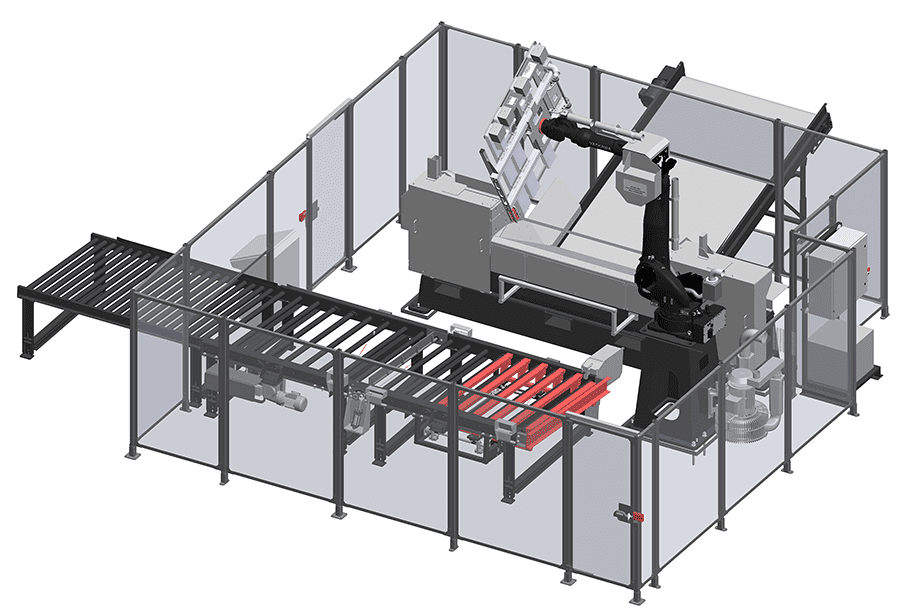

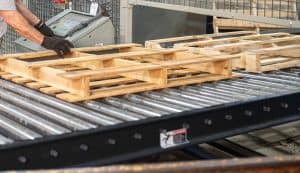
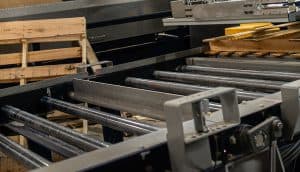
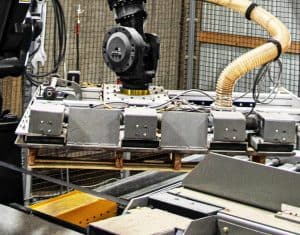
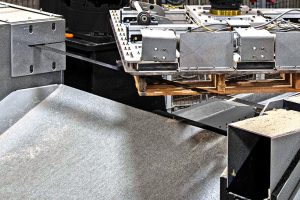

Customization based on your needs.
Combine with the
Urban Sawmill
Combine with the
Badger Sawmill Series
Combine with our
Sort & Repair Systems
Robotic Pallet Dismantler
Tear down 100 pallets per hour.
The Robotic Pallet Dismantler marked the entry point into the pallet recycling industry for Alliance Automation. Alliance sought to improve the processes involved in wooden pallets, especially the dangerous and tedious process of tearing down pallets.
The initial goal of automation for the pallet industry was to offer safer and greener solutions while keeping employees, imbuing them with advanced skillsets to oversee automation instead of being pushed out by it.
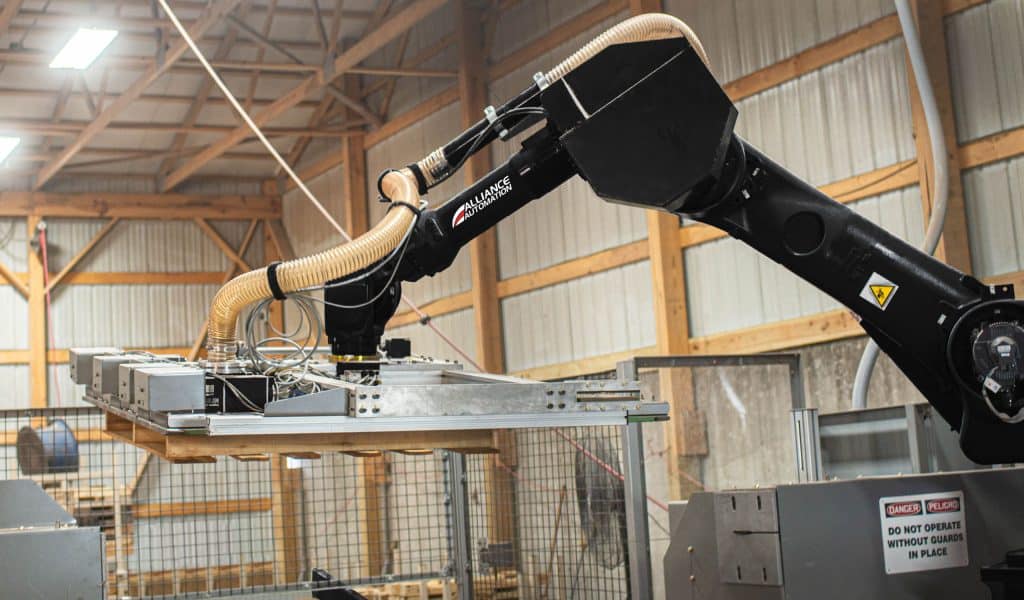
DYNAMIC DUO Robotic Pallet Dismantler feeding the Badger Sawmill Series
When working together, this dynamic duo will increase efficiency, yield, throughput and safety.
Empower your growth with EQUIPMENT FINANCING!
Structured financing allows you to get maximum benefit from your investment with minimal bottom line impact, all while building equity towards equipment ownership. We have partnerships with long-tenured lease and finance managers who understand the industry to help you to explore all of your options. Learn more about our financing options.

ROBOTIC PALLET DISMANTLER PRODUCT BROCHURE
Take a closer look at the benefits your company will gain with the Robotic Pallet Dismantler. Follow the link to download the brochure.
ROBOTIC PALLET DISMANTLER
PRODUCT BROCHURE
Take a closer look at the benefits your company will gain with the Robotic Pallet Dismantler. Follow the link to download the brochure.

-EUROPEAN PALLETS-
ROBOTIC PALLET DISMANTLER
PRODUCT BROCHURE
The Robotic Pallet Dismantler will also tear down European pallets. Follow the link to download the brochure.
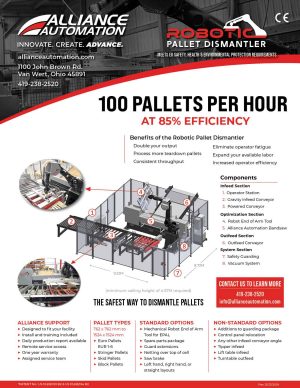
ROBOTIC PALLET DISMANTLER SPARE PARTS PACKAGE
With the purchase of a Robotic Pallet Dismantler, we offer a spare parts package. Click the link to view and download our spare parts package.
Robotic Pallet Dismantler FAQ
- The average lead time is 12-14 weeks.
- Many options can make the price go one way or the other. A standard system would be roughly $460,000 installed (does not include shipping).
- Shipping costs are not included in the quote for the Robotic Pallet Dismantler.
- Customers may arrange shipping at their own expense. Standard System Requirements are (2) 53’ Conestoga (Curtain Side) Trailers. Alliance Automation can arrange shipping. A quotation will be provided upon request.
- The shipping cost in this quotation is only an estimate. At the time of shipment, costs will be reevaluated, and any additional costs will be passed to the customer.
- Alliance is responsible for rigging equipment onto trucks at Alliance Automation in Van Wert, Ohio. Customers will be responsible for rigging equipment and placing the equipment on the floor where it is to be installed.
- The payment terms for the Robotic Pallet Dismantler is 50% invoiced upon Receipt of Purchase Order, 40% Invoiced prior to shipment of Equipment, and 10% Invoiced upon completion of installation. Due Net 30 Days, payments must be in U.S. Dollars
- We work with lending companies to provide deferred payment options, talk to your sales rep about this availability.
FACILITY
- The customers facility must supply 480 volts / 3 Ph / 60 Hz (each system fused @ 100 amps) input power. Other voltages shall be obtained by transformers and power supplies within the controls enclosure.
- Clean dry air at 30 CFM @ 80 PSI.
- Temperature of 32℉ to 104℉ or 0℃ to +40℃
- Humidity (%): 20-80
- Concrete floor with a minimum thickness of 8” for a 10’ x 10’ area for robot support. Concrete must be level within a ¼” over the noted area above. Robot will be anchored to the floor.
- Minimum ceiling height of 15’, if this cannot be supplied Alliance and customer to discuss.
- Standard guarding is 2,170 mm tall or 7 feet tall.
- We also provide an option that adds an additional 1,490 mm or 4.8 feet extension on top.
- You can also add netting to go over the entire guarding cell to prevent large debris from flying out.
MAINTENANCE
- Operators classifying the pallet wrong or loads the pallet in a manner that is not the best for picking.
- The operators get a rhythm for running the machine. They learn when to beat down the nails and if they should load the pallet top deck up vs. top deck down to allow for better picking.
- Loose boards, pallets incapable of being conveyed to the pick station, or held on via vacuum by the end of arm tool would cause some pallets not to be processed. Also, pallets need to be dry and free of debris for the system to operate properly.
- Customers will place an air knife on the system before it enters the pick station to remove excess dust.
- You would also need to add a dust collection system to capture and remove the dust from that area (or hook up to the central plant exhaust system).
- We always require customers to have an ethernet cable dropped to the equipment so that we can remote in and help troubleshoot if needed.
- Most of the maintenance on these machines involves chains, greasing, sensor alignment, and normal stuff that anyone with conveyors deals with.
- The robot is not something that you will have much to do as it runs like a tank.
- The saw is just a larger version (much larger) of a typical bandsaw
- We have an entire group of service and support folks that travel all over North America and provide phone support as needed.
- Yes, we can change the sequence to control how the last drop of deck boards fall across the belt.
- There is an operator there who manually picks up the blocks and saves them or disposes of them. We have also placed a scrap conveyor around the operator area so that they can take all scrap to a single collection point.
BLADES AND FOAM
- It greatly depends on the types of pallets you are running and the number of nails. Hardwood pallets with a ton of nails will reduce the blade life, while pine wood pallets with standard nails will get better blade utilization.
- 1,800-3,000 pallets would be the average. It could be more or less, depending on the above info.
- Each blade costs $125.00. We tell our customers to estimate between .25-.30 per pallet in foam and blade costs (Covers both).
- The blade is a 2.00 x .050 x 31’11” standard 5/8 tooth bi-metallic blade.
- Each foam pad costs $224. We our customers to estimate between .25-.30 per pallet in foam and blade costs (Covers both)
- The average number is between 2-3,000 pallets for pallet life.
- The foam pad life depends on how well you prep the pallets, clean the tool according to recommendations, and run the equipment properly.
- Cleaning the tool after every shift will extend pad life, on average it takes 30 minutes per shift to properly clean and inspect the tool.
- Not running wet pallets also extends the life of the foam pads.
BENEFITS
- Double your output
- Process more teardown pallets
- Consistent throughput
- Eliminate operator fatigue
- Expand your available labor
- Safer work environment
ALLIANCE SUPPORT
- Concept designed to fit your facility
- Install and training included
- Daily production report available
- Remote service access
- One year warranty
- Assigned service team
ADDITIONAL OPTIONS
- Peripheral equipment integration
- Tipper infeed
- Turntable outfeed
- Multi-robot dismantler layout
- Multi-year service plans
- Consumables replacement plan
You Can't Afford Not to Adopt Automation
Think automation is too expensive for your business? Think again.
With the help of our current automation users, we have developed a payback calculator to show how affordable adopting automation is. Click the link below and enter in your company’s data to see just how cost-effective automation can be for you.